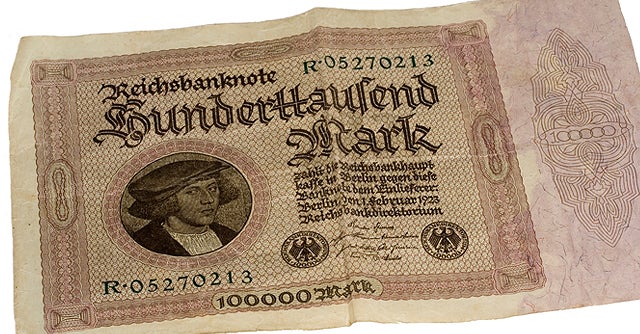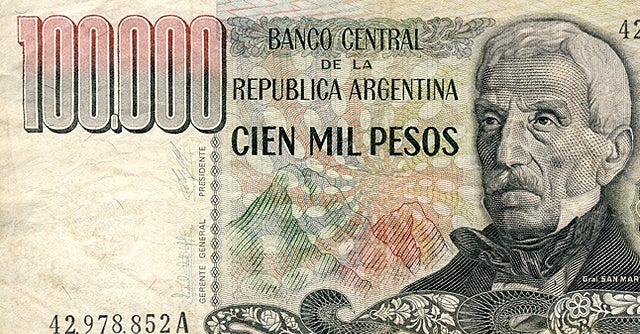M2RB: Pink Floyd
Money, it's a gas...
From Investopedia:
Some
of the countries that adopted the euro now find themselves in the position of
being unable to independently manage their monetary policy. What is being done
to establish financial stability? Essentially, new money is being pumped
into Greece and Ireland via the European Central Bank and International
Monetary Fund. This raises the question of what these actions
portend for the long-term health of the euro. History may provide some
answers.
1. Papiermark (Germany)

The
Weimar Republic after World War I was the original poster child for failed
currencies. A condition of the Treaty of Versailles required Germany to
pay war reparations to the allied nations.
When Germany failed to honor the
repayments, France and Belgium occupied parts of the German industrialized
areas. This pressured the German government to print money to pay salaries
and the war debt, and hyperinflation set
in. When the Rentenmark was introduced to replace the existing currency,
the exchange rate was 1 for 1 trillion.
2. Peso (Argentina)

Argentina's economy enjoyed record
growth until the OPEC oil embargo in the mid-70s. Civil and political unrest
followed, and budget and trade deficits threatened the onset of a severe recession. Rather than reduce
spending or institute temporary borrowing to cover the shortfall, the
government resorted to printing money. A military coup in 1976 brought further
economic decline and more inflation as the money supply continued to
expand. By 1982, GDP was in freefall and dropped 12% year over year, the
worst since the Great Depression. Inflation was rampant as the
money denominations kept adding zeros until the new peso was established to
stabilize the currency. In the end, one new peso was equal to 100
billion of the original pesos (pre-1983).
3. Dollar (Zimbabwe)

Upon gaining its independence in 1980, the
Zimbabwe dollar was valued about 25% higher than the U.S. dollar. However,
many problems led to economic decline over the next several years. The
problems were compounded by a military coup attempt that created more
instability and lack of confidence in the financial system. As
government spending escalated, wage and price controls were implemented
that produced massive budget deficits. The printing presses started
rolling and rampant inflation took hold. It reached 624% in 2004 and 1730%
in 2006. A year later, inflation zoomed to 11,000% and money was
denominated in increments of 100 million dollars. This was quickly replaced
by a 500 million dollar bill that was equivalent to about 2.5 U.S.
dollars. In 2008, the money was replaced by a new dollar that was equal to
10 billion of the old dollars.
4. Sol (Peru)

Originally an inviting target for foreign
investment, Peru embarked on a program of increased public spending in
the 1980s without a plan for dealing with the resulting
debt. Investment dried up as liberalized trade policies slowed growth and
inflation started to rise. In 1985, the government replaced the Sol with
the Inti at an exchange rate of 1,000 to 1. The largest denomination of
the new bill was 1,000 Inti note. By September 1990, monthly
inflation had reached 400% and a 10 million inti note was created to deal
with hyperinflated prices for goods and services. Only six years after
its creation, the Inti was replaced by a new version of the Sol with a
conversion rate of one billion to one.
5. Escudo (Chile)

Salvador Allende was elected president of Chile
in 1970. An avowed Marxist and
member of the Socialist Party, he nationalized industries and
dramatically increased social spending to redistribute wealth to the
poor. To pay for this, he adopted an expansive monetary policy that
initially produced economic growth, but also fueled a rise in inflation. By
the end of 1972, inflation had reached 600%. The rate had doubled to
1,200% within one year and the government defaulted on debts owed to other
countries and international banks. The Allende government was overthrown
and he committed suicide. In 1985 the Escudo was replaced by the new peso
at a 1,000 to 1 rate.
Lessons Learned

When it comes to the value and
stability of a currency, there is no free lunch. A nation's currency is
not exempt from the laws of supply and demand, so the more that is printed, the
less it is worth. While expanding the money supply may be needed in an
emergency situation, it's very difficult to reverse this policy once the emergency
has abated. As history shows, it usually takes a crisis and uncontrolled
inflation before painful steps are taken to stabilize the currency and reverse
the economic damage. (For related reading, check out The Taylor Rule: An Economic Model For Monetary Policy.)
Related:
http://tinyurl.com/az229o6
No comments:
Post a Comment